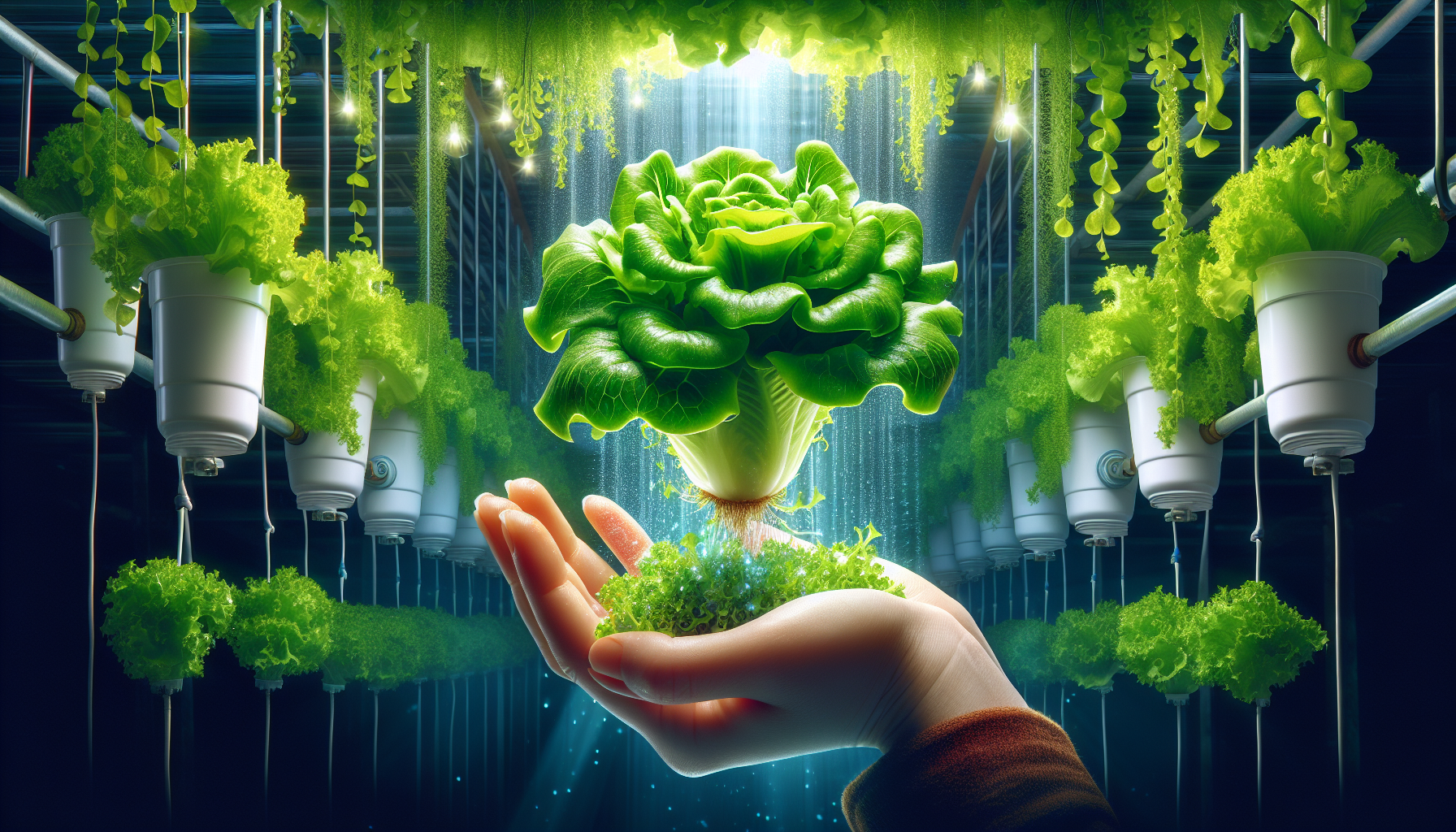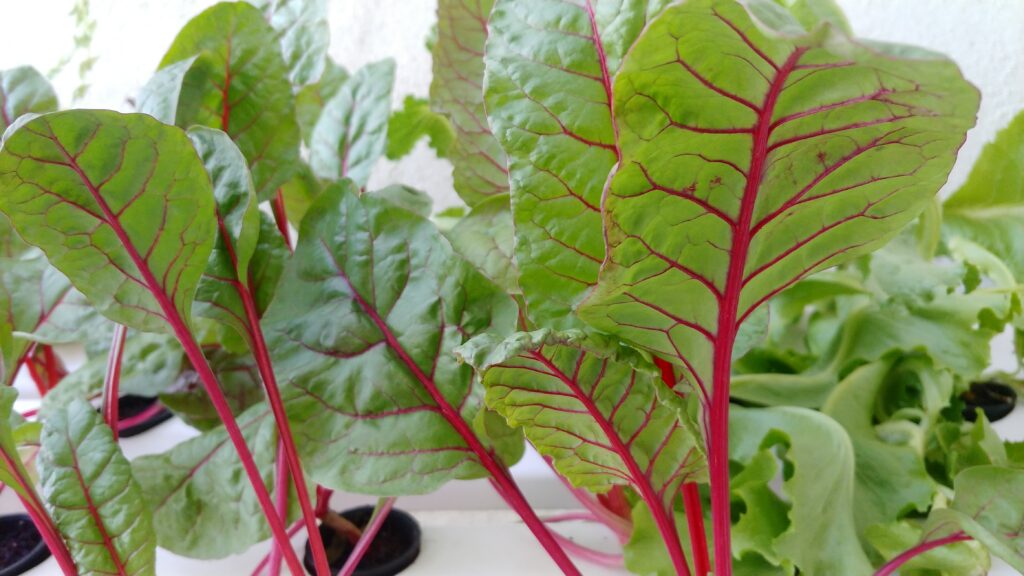Have you ever wondered how you can grow your own fresh produce indoors, without the need for soil? Well, look no further than hydroponic gardens! Hydroponic gardens are a fascinating and innovative approach to gardening that allows you to cultivate plants using water instead of soil. By providing all the necessary nutrients directly to the roots, hydroponics ensures optimal growth and produces amazingly flavorful fruits, vegetables, and herbs. Let’s explore the wonders of hydroponic gardens and discover how you can create your very own thriving garden right at home.

What is a Hydroponic Garden?
A hydroponic garden is a type of gardening system that allows plants to grow without soil. Instead, plants are grown in water-based nutrient solutions or in a medium like perlite or coco coir. This innovative method of gardening has gained popularity in recent years due to its numerous benefits and the ability to grow plants in a controlled environment.
Definition
Hydroponics is a method of growing plants without the use of soil. Instead, plants are grown in a water-based solution that contains all the necessary nutrients for their growth. This solution is carefully balanced to provide optimal conditions for plant growth, eliminating the need for soil. Hydroponic gardens can be set up indoors or outdoors and can range from small-scale systems for home use to large commercial operations.
History
The history of hydroponics can be traced back to ancient civilizations such as the Hanging Gardens of Babylon. However, the modern concept of hydroponics emerged in the 19th century with the discovery that plants can absorb nutrients directly from water. Since then, hydroponic gardening has evolved and been refined, with significant advancements in technology and research contributing to its popularity today.
Benefits
Hydroponic gardening offers a range of benefits that make it an attractive option for growers. Firstly, hydroponic gardens require less water compared to traditional soil gardens. This is because the water used in hydroponic systems is recirculated, minimizing water wastage. Additionally, hydroponic gardens can be set up in urban environments with limited space, allowing for the cultivation of fresh produce in areas where traditional gardening might not be possible. Hydroponics also enables faster plant growth and higher yields, as plants have constant access to the nutrients they need. Furthermore, hydroponic systems eliminate the problem of soil compaction and weeds, making plant maintenance much easier.

Types of Hydroponic Systems
There are several different types of hydroponic systems, each with its own unique characteristics and advantages. These systems can vary in complexity and size, catering to the needs and preferences of different growers. Some commonly used hydroponic systems include:
Deep Water Culture (DWC)
In a Deep Water Culture system, plants are suspended above a nutrient solution in a reservoir. The roots of the plants are submerged in the solution, allowing them to take up nutrients and oxygen. Oxygen is supplied through air stones or diffusers, ensuring that the roots remain healthy and well-aerated.
Nutrient Film Technique (NFT)
The Nutrient Film Technique involves a thin film of nutrient-rich water flowing over the roots of the plants. This system utilizes a sloping channel or gully, allowing the nutrient solution to flow continuously. The roots are exposed to the solution, absorbing the necessary nutrients as they grow.
Drip Irrigation
Drip irrigation is a widely used hydroponic system where a drip line delivers nutrient-rich water to the base of each plant. This system provides precise control over the amount of water and nutrients received by each plant, making it ideal for larger-scale operations.
Aeroponics
Aeroponics is a high-tech hydroponic system that involves suspending the plants in air and misting their roots with a nutrient solution. The mist contains tiny droplets that provide the plants with water, oxygen, and nutrients. This system allows for maximum aeration and nutrient absorption, promoting rapid growth.
Ebb and Flow
In an Ebb and Flow system, plants are placed in growing trays filled with a growing medium. The nutrient solution is periodically pumped into the tray, flooding it, and then drained back into the reservoir. This cyclical flooding and draining provide the plants with nutrients and oxygen while preventing waterlogging.
Wicking System
The wicking system is one of the simplest and most low-maintenance hydroponic systems. It involves using a growing medium that wicks up the nutrient solution from a reservoir to the roots of the plants. This passive system provides a consistent supply of water and nutrients to the plants.
Advantages of Hydroponic Gardens
Hydroponic gardens offer numerous advantages over traditional soil gardens. These benefits have contributed to the increasing popularity of hydroponics among gardeners and commercial growers alike.
Water Conservation
One of the key advantages of hydroponic gardening is its ability to significantly reduce water usage. In traditional soil gardens, a large amount of water is lost through evaporation and runoff. In hydroponic systems, water is recirculated and can be used multiple times, resulting in significant water conservation.
Faster Growth and Higher Yields
Plants grown hydroponically often experience faster growth rates and produce higher yields compared to those grown in soil. This is because hydroponic systems provide plants with a constant supply of nutrients, allowing them to focus energy on growth rather than searching for nutrients in the soil. Additionally, hydroponic gardens can be optimized for ideal growing conditions, resulting in healthy and robust plants.
Optimal Nutrient Control
Hydroponic gardens provide growers with the ability to closely monitor and control the nutrient levels in the growing environment. This allows for precise adjustment of nutrient concentrations, ensuring that plants receive an optimal balance of essential elements for their growth. By customizing nutrient solutions, growers can provide plants with all the necessary nutrients, resulting in healthier and more productive crops.
Year-round Production
One of the advantages of hydroponic gardening is the ability to grow plants year-round, regardless of climate or season. By creating an indoor or controlled environment, growers can manipulate temperature, light, and other environmental factors to mimic the ideal growing conditions of any plant. This makes hydroponic gardening particularly valuable in regions with harsh climate conditions or limited growing seasons.
No Soil Compaction or Weeds
Hydroponic gardening eliminates the need for soil, which often becomes compacted and hinders root growth. The absence of soil compaction in hydroponic systems allows roots to spread freely and take up nutrients more efficiently. Additionally, hydroponic gardens are virtually weed-free, as there is no soil for weeds to grow in. This saves time and effort spent on weeding and reduces competition for nutrients and water.
Space Efficiency
Hydroponic gardens are ideal for growers with limited space. Unlike traditional gardens that require large areas of land, hydroponic systems can be set up vertically or in smaller areas, maximizing space utilization. This makes hydroponics suitable for urban environments, balconies, or small backyards.

Setting Up a Hydroponic Garden
Setting up a hydroponic garden involves several key steps and considerations. By following these guidelines, growers can create a successful hydroponic system and enjoy the benefits of this innovative gardening method.
Choosing a Location
When selecting a location for a hydroponic garden, it is important to consider factors such as sunlight exposure, temperature control, and accessibility. Ideally, the chosen location should receive adequate sunlight for the specific plants being grown. It should also have proper ventilation to ensure consistent airflow, which is crucial for preventing disease and maintaining optimal temperature and humidity levels.
Selecting the Right System
Choosing the right hydroponic system is essential for the success of a hydroponic garden. Factors such as available space, budget, and personal preferences should be taken into account when selecting a system. Consider the pros and cons of each type of system and choose one that suits the specific needs and requirements of the plants being grown.
Lighting and Temperature Requirements
Hydroponic gardens often require supplemental lighting, especially when grown indoors. Different plants have varying light requirements, so it is important to choose the appropriate lighting system. LED grow lights are commonly used in hydroponics due to their energy efficiency and ability to provide the specific light spectrum needed for plant growth.
Temperature control is also crucial in hydroponic gardening. Most plants thrive within a specific temperature range, so it is important to monitor and adjust the temperature accordingly. This can be done using heaters, fans, or air conditioning units to maintain an optimal growing environment.
Choosing the Growing Medium
The choice of growing medium in a hydroponic garden depends on the specific system being used and the type of plants being grown. Growing mediums such as perlite, coco coir, rockwool, or clay pellets provide support for the roots and help maintain moisture levels. It is important to select a growing medium that retains water adequately while allowing for proper drainage to prevent waterlogging.
Monitoring and Adjusting pH and EC Levels
pH and EC levels refer to the acidity/alkalinity and nutrient concentration of the water in the hydroponic system. Monitoring and adjusting these levels are crucial for ensuring optimal plant growth. pH levels should be within a specific range suitable for the plants being grown, typically slightly acidic. pH test kits or digital meters can be used to measure and adjust the pH as needed.
EC levels indicate the concentration of nutrients in the water. It is important to regularly monitor and adjust the nutrient solution to maintain optimal EC levels for healthy plant growth. This can be done using EC meters and by following the manufacturer’s recommendations for nutrient concentrations.
Selecting the Suitable Nutrients
Hydroponic plants rely on nutrient solutions for their growth and development. Choosing the right nutrients is essential for plant health and productivity. There are different formulations available for different plant types and growth stages. Follow the instructions provided by the nutrient manufacturer and adjust nutrient concentrations based on the specific needs of the plants being grown.
Plants Suitable for Hydroponic Gardens
Hydroponic gardening offers a wide range of possibilities when it comes to plant selection. While almost any plant can be grown hydroponically, certain crops are particularly well-suited for this method of cultivation. Some popular plants suitable for hydroponic gardens include:
Leafy Greens
Leafy greens such as lettuce, spinach, kale, and Swiss chard are highly suitable for hydroponic gardening. These crops have shallow root systems and relatively short growth cycles, making them perfect for smaller, faster-growing hydroponic systems.
Herbs
Herbs like basil, mint, cilantro, and parsley thrive in hydroponic gardens. They require relatively low light levels and have high water requirements, making them well-suited for water-based systems.
Strawberries
Strawberries can be successfully grown hydroponically, making them an attractive option for home gardeners. This method allows for precise control of the growing conditions, resulting in sweeter and juicier strawberries.
Tomatoes
Tomatoes are well-known for their productivity in hydroponic systems. These high-yielding plants can be grown vertically, making efficient use of space in hydroponic gardens.
Peppers
Both sweet and hot peppers can thrive in hydroponic gardens. With proper care and nutrient management, peppers grown hydroponically can produce high-quality fruits with vibrant flavors.
Cucumbers
Cucumbers are another popular choice for hydroponic gardens. These vining plants benefit from vertical setups and can produce a continuous harvest of crisp and flavorful cucumbers.

Common Challenges in Hydroponic Gardening
While hydroponic gardening offers numerous benefits, it also presents certain challenges that growers must be aware of and address. By understanding and addressing these challenges, growers can overcome potential issues and ensure the success of their hydroponic gardens.
Algae and Disease Control
Hydroponic systems provide an ideal environment for algae growth due to the presence of moisture and nutrients. Algae can compete with plants for nutrients and sunlight, leading to decreased plant growth. Regular monitoring and proper maintenance, such as cleaning and sterilizing equipment, can help control algae growth. Additionally, maintaining proper airflow and ventilation can reduce the risk of diseases such as fungal infections.
Managing pH Fluctuations
pH fluctuations can significantly affect plant health and nutrient absorption in a hydroponic system. The pH of the nutrient solution should be regularly monitored and adjusted within the suitable range for the plants being grown. pH buffers or acid/base solutions can be used to raise or lower pH levels as needed.
Maintaining Proper Oxygen Levels
In hydroponic systems, oxygen is crucial for healthy root growth. Oxygen deficiency can lead to root rot and other plant diseases. Proper aeration and oxygenation of the nutrient solution are essential. Air stones, air pumps, or other aeration devices can be used to ensure adequate oxygen levels in the system.
Nutrient Imbalances
Maintaining the proper nutrient balance is vital in hydroponic gardening. Nutrient deficiencies or excesses can negatively impact plant health and productivity. Regularly monitoring the nutrient solution’s EC levels and adjusting the nutrient concentrations as needed will help prevent nutrient imbalances.
Root Rot Prevention
Root rot is a common issue in hydroponic gardens caused by overwatering or poor drainage. Proper substrate selection, frequent monitoring of moisture levels, and a well-designed drainage system can help prevent root rot and maintain healthy root systems.
Temperature and Humidity Control
Maintaining suitable temperature and humidity levels in a hydroponic garden is critical for plant health. High temperatures can lead to decreased nutrient absorption, while excessively low temperatures can stunt plant growth. Regular monitoring and the use of temperature and humidity control equipment can help maintain optimal growing conditions.
DIY Hydroponic Garden Projects
For those interested in starting a hydroponic garden on a smaller scale or as a fun DIY project, several simple and affordable options are available. These DIY projects allow beginners to explore the world of hydroponics and experience the joy of growing their own fresh produce.
Basic PVC System
A basic PVC system involves using PVC pipes, fittings, and net cups to create a simple hydroponic setup. This system is easy to build and can be scaled up or down depending on available space. It is ideal for growing smaller plants like herbs or leafy greens.
Bucket Bubbler System
The bucket bubbler system is another popular DIY project for hydroponic gardening. It utilizes a plastic bucket or container, an air pump, and air stones to create an oxygen-rich environment for plant roots. This system is affordable, easy to set up, and suitable for growing a variety of plants.
Vertical Tower Garden
Vertical tower gardens are an excellent option for maximizing space and growing a large number of plants. These systems feature stacked layers of growing containers or troughs that utilize drip irrigation or nutrient film technique. Vertical tower gardens are particularly suitable for leafy greens, herbs, and strawberries.
Window Farming
Window farming is a great way to make use of available natural light in urban apartments or small spaces. It involves suspending plants in a vertical arrangement near a window, allowing them to receive adequate sunlight. This method is ideal for growing herbs or small leafy greens like lettuce.
Simple Kratky Method
The Kratky method is a passive hydroponic system that requires minimal equipment and maintenance. In this method, plants are grown in containers filled with a nutrient solution. As the plants grow, they absorb the nutrients and create an air gap between the solution and the roots. The simplicity of this method makes it accessible to beginners or those with limited resources.

Hydroponic Farming in Urban Environments
Hydroponic gardening is particularly well-suited for urban environments, where space constraints and limitations on traditional agriculture can hinder fresh produce accessibility. Several innovative techniques and models have emerged to bring hydroponic farming to urban areas.
Vertical Farming
Vertical farming involves growing plants in vertically stacked layers or racks. This method maximizes space utilization and allows for large-scale production in urban settings. Vertical farming is commonly used for leafy greens and herbs and utilizes techniques such as hydroponics or aeroponics.
Roof Gardens
Roof gardens make use of unused rooftop spaces in urban areas to create productive green spaces. With rooftop hydroponic gardens, city-dwellers can grow fresh produce and enjoy the benefits of urban agriculture. Roof gardens can help insulate buildings, reduce the urban heat island effect, and improve air quality.
Community Gardens
Community gardens play a vital role in bringing hydroponic farming to urban environments. These gardens are often collectively managed by community members, providing an opportunity for education, collaboration, and access to fresh produce. Hydroponic community gardens can foster a sense of community and promote sustainable food production.
Indoor Farming
Indoor farming involves utilizing controlled indoor environments, such as warehouses or shipping containers, for hydroponic farming. This method allows for year-round production of fresh produce in any location, regardless of climate. Indoor farms often use advanced technologies such as LED lighting, vertical growing systems, and climate control to optimize plant growth.
Hydroponic Gardens vs. Traditional Soil Gardens
Comparing hydroponic gardens to traditional soil gardens can help highlight the advantages and differences between these two methods of cultivation.
Water Usage
Hydroponic gardens significantly reduce water usage compared to traditional soil gardens. In hydroponic systems, water is recirculated, minimizing water wastage. On the other hand, traditional soil gardens require regular watering, which can result in water evaporation and runoff.
Space Utilization
Hydroponic gardens allow for efficient space utilization, making them suitable for urban environments or areas with limited land. Vertical hydroponic systems maximize growing area, enabling higher yields in a smaller space. Traditional soil gardens require larger areas of land, limiting their feasibility in urban settings.
Nutrient Efficiency
Hydroponic systems provide plants with a precisely balanced nutrient solution, ensuring optimal nutrient uptake. This leads to improved nutrient efficiency and enhanced plant growth. In traditional soil gardens, nutrients can be lost through leaching or may be unevenly distributed, resulting in less efficient nutrient absorption.
Pest and Disease Management
Hydroponic systems tend to have fewer issues with pests and diseases compared to traditional soil gardens. Soil-borne pests and diseases are minimized in hydroponic gardens, reducing the need for chemical pesticides. However, hydroponic systems can still be susceptible to specific pests and diseases that affect plants grown in water-based environments.
Yield Comparison
Hydroponic gardens often yield higher quantities of produce compared to traditional soil gardens. The controlled environment and optimal nutrient delivery provided by hydroponic systems contribute to faster growth rates and increased productivity. Traditional soil gardens may be subject to factors such as soil fertility, weather conditions, and pests, which can affect yields.
Leading Companies and Innovations in Hydroponic Farming
The field of hydroponic farming has seen significant advancements in recent years, with several leading companies and innovative solutions emerging. These companies are at the forefront of pushing the boundaries of hydroponic farming and embracing sustainable agricultural practices.
AeroFarms
AeroFarms is a vertical farming company that specializes in growing leafy greens and herbs using aeroponic technology. With their patented indoor vertical farming system, AeroFarms cultivates greens that are grown in a misty, nutrient-rich environment. They aim to create a more sustainable and resilient food system.
BrightFarms
BrightFarms focuses on creating sustainable greenhouse farms that produce local and fresh produce. They build and operate hydroponic greenhouses near major markets, allowing for year-round production and reduced transportation costs. Their goal is to provide consumers with the freshest and most flavorful local produce available.
Fifth Season
Fifth Season is a Pittsburgh-based vertical farming company that utilizes automated robotic systems for their indoor hydroponic farms. Their farms offer precise control over temperature, lighting, and nutrients, resulting in consistent and high-quality produce. Fifth Season aims to transform the indoor farming industry and make fresh produce more accessible.
Vertical Harvest
Vertical Harvest operates a vertical hydroponic farm in Jackson, Wyoming. Their unique facility is built on a small urban footprint, utilizing vertical growing techniques. Vertical Harvest focuses on providing locally grown produce to the community while creating jobs for individuals with disabilities.
AppHarvest
AppHarvest is a Kentucky-based company that specializes in large-scale hydroponic farming. They utilize high-tech greenhouses and LED lighting to grow a variety of crops sustainably. AppHarvest aims to revolutionize agriculture by using less water, reducing chemical usage, and providing fresh produce to local communities.
Urban Crop Solutions
Urban Crop Solutions is a Belgian company that specializes in manufacturing and developing automated indoor hydroponic systems. They offer a range of turnkey solutions for various crops, including leafy greens, herbs, and even medicinal plants. Urban Crop Solutions aims to support future farming by bringing production closer to the consumer while minimizing environmental impact.
In conclusion, hydroponic gardening offers a sustainable and efficient way to grow plants without soil. With a wide variety of systems to choose from and numerous advantages over traditional soil gardens, hydroponics has gained popularity among home gardeners and commercial growers alike. Whether setting up a DIY project or exploring large-scale urban farming, hydroponics provides a versatile solution for fresh produce cultivation in any environment.




